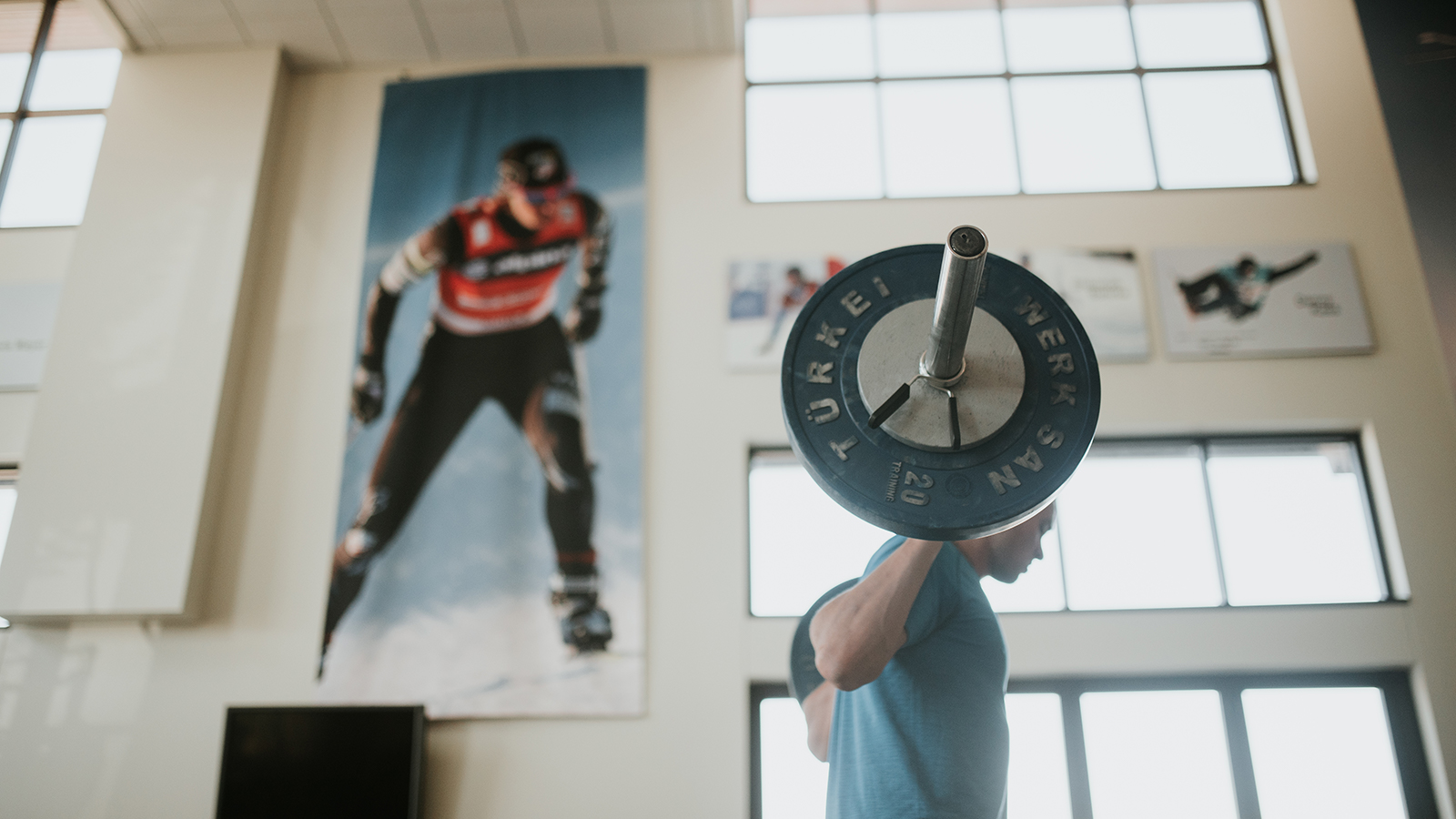Eat to Compete
11.28.2017 | Gabbi Hall

At the 2002 Salt Lake City Olympic Winter Games, British skier Alain Baxter secured a bronze medal in the men’s slalom competition. Days later, officials stripped Baxter of his medal due to a doping violation that stemmed from a mix-up with cold medication. Neither he, his coaches, nor his team doctors checked the ingredients on the U.S. version of a Vicks nasal inhaler for possible banned substances before Baxter used it during the Games since the U.K. version of the product did not contain any.
It’s this story that Gar Trayner, director of athletic development at Killington Mountain School, uses time and time again to warn his athletes about the perils of not checking the ingredients of the foods and substances they put in their bodies. Trayner was a teammate of Baxter’s at the Olympic Winter Games and remembers the aftermath vividly. He prefers to eat by the idea that you should be able to pronounce the word on the label if you plan to put it in your body.
“Often, if I catch athletes with pre-bottled sports drinks or energy drinks, you know I say to them, ‘Read me that ingredient list,” Traynor explains. “And they can’t pronounce half the words on there, which suggests there’s a lot of chemicals in there.”

In Season 3 of NBC’s hit comedy Parks & Recreation, Andy Dwyer contemplates the issue of what is in his milk.
Trayner is certainly not alone in the practice of clean eating to fuel athletes — or any human for that matter. Mariann Conlon, a holistic health coach, taught a nutrition course at Okemo Mountain School for three years called “Eat to Compete” and currently sits on the school’s board. She first became heavily involved in nutrition thanks to her kids, who were both ski racers.
“I tell the kids that their body is their most important piece of equipment when it comes to ski racing,” Conlon says. “They wouldn’t be at OMS if they weren’t elite athletes. They have access to the best technical equipment and top notch OMS coaches. If they want to differentiate themselves and have a competitive edge over other elite athletes, they have to prepare their body with wholesome food for intensive training and competitive racing.”
Conlon’s approach, which reflects a popular Vermont attitude, is to impress upon athletes the power of eating local, seasonal, and organic foods. She also encourages athletes to learn how to make their own food. It’s the kind of approach that guarantees athletes understand what’s going into their system.
“Each kid takes the time to tune and wax their skis, to run numerous gates and practice difficult drills,” she continues. “Why on earth would they short change themselves by not preparing their body with quality nutrition?”
One of the ways in which Conlon sees athletes short changing themselves is at breakfast, commonly referred to as the most important meal of the day.
“The big mistake I see a lot of athletes make is that they either skip breakfast or make poor choices,” Conlon says. “Mornings are hectic, and I think that’s where a lot of athletes diets fall short. That’s when they tend to grab processed foods like the protein bar, the Muscle Milk, but with some planning, breakfast can be nutritious and hydrating.”
The protein-packed products that Conlon refers to are also a point of concern for Trayner.
“I’m a large proponent that any supplement should be either batch tested or pharmaceutically packaged, meaning that there’s exponentially less chance of any cross-contamination,” he explains. “And that’s kind of the problem at times with GNC or a lot of these mainstream products. These companies also have lines of body-building products, and the risk of cross-contamination is pretty scary to me, so it has to be responsibly sourced.”
While Trayner admits that the chance of accidentally running into a banned substance is rather small, it’s a teachable moment to remind athletes that there are risks in certain types of food and also ways to mitigate those risks. Plus, getting enough protein is a crucial part of any ski racer’s diet.
Dr. Katherine Beals is an associate professor of nutrition and integrative physiology at the University of Utah who holds a doctorate in exercise and wellness with an emphasis in human nutrition. She explains that protein “is required for synthesis, maintenance, and repair of lean body mass including muscle tissue, tendons, ligaments, and bone.” Most people know that working out causes micro tears in muscles, and protein is a required building block for the muscles to repair. Protein requirements vary by athlete particularly based on body type and workout.
“Protein requirements are set relative to body mass,” Beals explains, “For a young athlete training daily, the range is 1.5-1.8 grams of protein per kilogram of body weight — maybe even up to 2.0 if the athlete is still actively growing and engaged in rigorous training. More than 2.0 grams of protein per kilogram of body weight will not provide any benefit and could result in displacing other key nutrients from the diet, particularly carbohydrates.”
Consuming too much protein can also lead to other health issues.
“Too much protein causes dehydration,” Conlon says. “Dehydration, as we know, is a mess for any athlete. It causes muscle fatigue, lack of optimal performance, so these kids think that they’re doing themselves a favor by consuming things like Muscle Milk, when it’s really too much protein for their bodies to process and it has a ricochet effect.”
The threat of possible dehydration is not a reason to be scared of protein, but more of a reminder that all things should be eaten in moderation. There are also optimal times and ways to consume the necessary protein.

Image Credit: Susie Theis
“The research indicates that spreading your protein intake out throughout the day, in equal portions of at least 20 grams, and consuming at least 20 grams within an hour post training creates the ‘optimal’ anabolic environment,” Beals says.
Beals, whose research often focuses specifically on the nutrition of athletes, says that protein needs do not vary by gender. The only factor is body mass, but women do have nutritional pitfalls to keep an eye on.
“Female athletes are at risk for low energy availability, for example not consuming enough calories to meet the demands of training, because many of them are trying to lose weight or maintain a low body weight,” Beals shares. “Addressing body image issues and calorie needs is crucial for female athletes. Female athletes are also at very high risk for iron deficiency — with or without anemia. So, ensuring that they are meeting their iron needs via iron-rich foods and having their iron status measured regularly by their physician is also crucial.”
All of these nutritional guidelines are complicated further when factoring in life on the road, jumping from gas station to gas station forced to choose between Doritos and a Coca-Cola or a bottle of water and mixed nuts.
“You’ve got a five-hour car ride to Sunday River, and you’re driving through lunch time, you’re going to eat at a gas station,” Trayner posits. “What are you going to eat?”
The KMS coach understands that challenge well, having experienced it during his time as an athlete. He recommends that athletes have go-to healthy snacks — either in mind or on hand — that they can always source.
“That can be a good place for supplementation,” he continues. “There are some protein powders and such that can be very handy when you’re traveling to maintain a protein level so your body is still both surviving and recovering.”
As Conlon puts it, preparation starts in the grocery store. Athletes and their parents should work together to buy healthy snacks and have them available whether it’s in an athlete’s jacket pocket on the hill or in a backpack on the road. And don’t forget a bottle of water because even if you avoid unhealthy foods, you also need to stay hydrated for the healthy foods to help.
For more articles like this one, visit SkiRacing.com